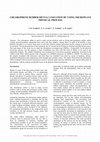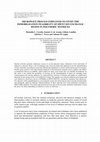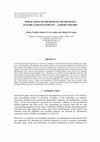Papers by Liliane Landini
57Co and 109Cd simultaneous production was studied, using composite targets of natNi and natAg. T... more 57Co and 109Cd simultaneous production was studied, using composite targets of natNi and natAg. The targets were irradiated at the CV-28 Cyclotron, with proton beams of 24 MeV. The average production yields of 57Co and 109Cd were 1179.93 kBq/A·h, produced by direct and indirect reactions (11.31 days after the EOB) and 71.41 kBq/A·h (EOB), respectively. The chemical separation procedure was

Materials Science Forum, 2020
In this work, it was proposed to study the feasibility of biodiesel production, from residues of ... more In this work, it was proposed to study the feasibility of biodiesel production, from residues of vegetable oils used in domestic activities, employing (CaCO3) shells prepared like calcium oxide (CaO) as catalysts, in a batch reaction unit, on bench scale, installed at IPEN-CNEN/SP. This unit is capable of operating with high pressure hydrogen gas (up to 200bar) and high temperature (up to 500°C, using microwave - MW (2.450MHz, with up to 2kW continuous and 8kW pulsed) and conventional heating – (electric) MC. In the tests, the oil load (mL), type and mass of catalyst, with or without hydrogen gas pressure (bar), temperature (°C), reaction time (h), microwave power (W), the speed of the load (rpm) agitation and the conventional heating were evaluated. The analytical determinations of the samples were carried out by means of density, gas chromatography (GC) and X-ray fluorescence. Data were collected in order to be compared with other methodologies, already used in the literature. The...

The chloroprene rubber is used to make several artefacts, such as diving and gymnastics outfits, ... more The chloroprene rubber is used to make several artefacts, such as diving and gymnastics outfits, cables coating, special pneumatic automobile tires, and in the shoe industry, among others. In spite of its benefits, a great problem nowadays is to recycle these used or with their lifetime expired galvanized articles, aiming to preserve the environment. The devulcanization of these products may be carried out by biological, chemical and physical processes. The main target of this work was to study the chloroprene recycling/re-use (DuPont - Neoprene®), by the physical microwave process. For this purpose, a basic formulation was done with this kind of rubber, to be used in the automobile industry. The samples irradiations were performed in a microwave generator equipment, developed at the CQMA of the IPEN, which operates with a frequency of 2,450MHz and power of 1,000W to 3,000W. The analyses of the samples irradiated with microwave and with those not irradiated were done by means of har...
Nowadays, there is a great concern regarding the recovery and recycling of reticulated polymers, ... more Nowadays, there is a great concern regarding the recovery and recycling of reticulated polymers, mainly for rubber based products. The scrap rubbers or leftovers from the industry become a serious environmental issue. Recycling of these products can be classified in ...

In the electromagnetic spectrum, the microwave radiation is located between infrared radiation an... more In the electromagnetic spectrum, the microwave radiation is located between infrared radiation and radio waves. The frequencies for industrial and scientific purposes are imposed by international convention being the 2.45GHz (wavelength of 12.2cm) the most routinely used. These kind of waves are used for selective heating of materials, whose molecular structures can be affected, depending on their dielectric properties. This phenomenon can be used for some purposes. In materials of multiple phases, some of these can syntonize more readily with these electromagnetic waves. Therefore, it is possible to process materials selectively with distinct phases of heating and to initiate chemical reactions in several composites. In this way, new materials have been developed and studied, such as, the rare earth elements (REEs). They can be used as catalysts, increasing the speed of the reactions in several chemical compounds. The objective of this work was to carry out a short literature inqui...

Nuclear activities generate radioactive wastes in several physical states, radioactive levels and... more Nuclear activities generate radioactive wastes in several physical states, radioactive levels and kinds of radioactive emission. Hence, a lot of techniques have been developed and optimized to do the immobilization of these materials, according to local and international regulations to protect human being and environment. Another great concern is the indiscriminate disposal of used polymeric materials (such as plastic and rubber) or production leftovers in landfills, which remain for many years before they are naturally decomposed. In this work, it was studied the possibility of carrying out the immobilization of spent ion exchange resins (contaminated with ionising radiation), by using polymeric matrices of bitumen and rubber (as solidification materials for the storage of low level radioactive waste). The samples were mixed at different percentages and were heated in a microwave device (2,450MHz) at IPEN/CNEN-SP, varying the irradiation time and power. The objective of the immobilization is converting the wastes into forms that are leach resistant and physically and chemically stable for disposal. Characterizations of these materials have been performed according to ABNT-NBR standards. The results indicated the previous idea of the necessary minimum temperature to keep the matrix for future embedding of radioactive waste, in solid state.

Among the vulcanized elastomers, the chloroprene rubber (DuPont Neoprene®-generic name) possesses... more Among the vulcanized elastomers, the chloroprene rubber (DuPont Neoprene®-generic name) possesses a good performance, being one of the most used in the current days. However, this kind of polymer causes a serious environmental problem if it is not reprocessed or recycled. A worldwide method that has been used and that is an important tool in the rubber devulcanization is microwave irradiation at high temperature Elastomer waste may be devulcanized without depolymerization and allows a new vulcanization into a product having physical properties essentially equivalent to the original vulcanized. In this work, the chloroprene samples were irradiated in microwave generator equipment with 2,450MHz (frequency) and 1,000W to 3,000W (power). The properties of samples (according to ASTM standards) were analyzed before and after irradiation. The degraded material after irradiation will be tested for re-use.
European Polymer Journal, 2007
This paper shows the results of preliminary assessment to devulcanize and recover the bromobutyl ... more This paper shows the results of preliminary assessment to devulcanize and recover the bromobutyl rubber (BIIR) using the microwave process. In this work, a heat generating system with high microwave frequency (2.45 GHz) was used. Samples of BIIR (about ...
In this work the thermal behavior of EVA samples after exposure to a microwave beam has been eval... more In this work the thermal behavior of EVA samples after exposure to a microwave beam has been evaluated. Three different EVA samples were used: 1) non-crosslinked pellets; 2) crosslinked and finely ground particles; and 3) type 2 particles mixed with non-crosslinked ...

ipen.br, 2002
In the electromagnetic spectrum, the microwave radiation is located between infrared radiation an... more In the electromagnetic spectrum, the microwave radiation is located between infrared radiation and radio waves. The frequencies for industrial and scientific purposes are imposed by international convention being the 2.45GHz (wavelength of 12.2cm) the most routinely used. These kind of waves are used for selective heating of materials, whose molecular structures can be affected, depending on their dielectric properties. This phenomenon can be used for some purposes. In materials of multiple phases, some of these can syntonize more readily with these electromagnetic waves. Therefore, it is possible to process materials selectively with distinct phases of heating and to initiate chemical reactions in several composites. In this way, new materials have been developed and studied, such as, the rare earth elements (REEs). They can be used as catalysts, increasing the speed of the reactions in several chemical compounds. The objective of this work was to carry out a short literature inquiry, related to the application of this methodology, using some elements of this family, for heating of materials, as the organic ones. A great improvement of microwave application has been attained, but these processes or technologies still need further researches.











Uploads
Papers by Liliane Landini